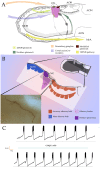Olfaction and Pheromones: Uncanonical Sensory Influences and Bulbar Interactions
- PMID: 29187814
- PMCID: PMC5695156
- DOI: 10.3389/fnana.2017.00108
Olfaction and Pheromones: Uncanonical Sensory Influences and Bulbar Interactions
Abstract
The rodent main and accessory olfactory systems (AOS) are considered functionally and anatomically segregated information-processing pathways. Each system is devoted to the detection of volatile odorants and pheromones, respectively. However, a growing number of evidences supports a cooperative interaction between them. For instance, at least four non-canonical receptor families (i.e., different from olfactory and vomeronasal receptor families) have been recently discovered. These atypical receptor families are expressed in the sensory organs of the nasal cavity and furnish parallel processing-pathways that detect specific stimuli and mediate specific behaviors as well. Aside from the receptor and functional diversity of these sensory modalities, they converge into a poorly understood bulbar area at the intersection of the main- main olfactory bulb (MOB) and accessory olfactory bulb (AOB) that has been termed olfactory limbus (OL). Given the intimate association the OL with specialized glomeruli (i.e., necklace and modified glomeruli) receiving uncanonical sensory afferences and its interactions with the MOB and AOB, the possibility that OL is a site of non-olfactory and atypical vomeronasal sensory decoding is discussed.
Keywords: olfaction; olfactory limbus; pheromone; sensory convergence.
Figures


References
Publication types
LinkOut - more resources
Full Text Sources
Other Literature Sources

